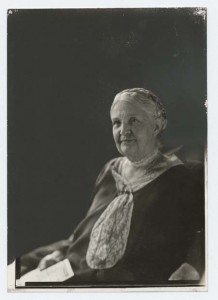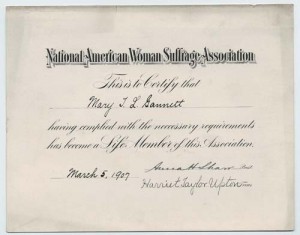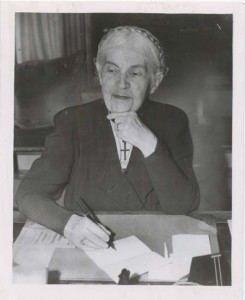 Born February 27, 1854
Born February 27, 1854
Birthplace Altoona, PA
Died October 26, 1952
Grave Site Cremated at Mt. Hope Cemetary, Rochester, NY
Contribution Educator, reformer and social activist
Quotation “Join Some Cause Not Your Own”
Mary Thorn Lewis, reformer and social activist, was born on February 27, 1854 in Altoona, Pennsylvania. Her parents were Enoch Lewis, a Philadelphia railroad executive, and Charlotte S. Thorn. Both parents were reform activists and members of the Religious Society of Friends (Quakers). Famous visitors to her girlhood home included William Lloyd Garrison, Jane Addams, and Susan B. Anthony.
Photograph of Mary and William Gannett with childShe was educated in private schools and at the University of Pennsylvania, where she studied chemistry for three years. She met her future husband, Rev. William C. Gannett, a Unitarian minister, in the mid 1870s. Upon their marriage on November 3, 1887, Mary Thorn Lewis Gannett moved to Hinsdale, Illinios, where her husband was pastor of the Unitarian Church. The couple were to have two children.
The Gannetts moved to Rochester, New York in June of 1889, when William C. Gannett accepted the pastorate of the First Unitarian Church. In Rochester, the pair became known as a formidable team in the city’s progressive reform movements of the late nineteenth and early twentieth centuries. They were so much of a team, in fact, that it is often hard to separate the accomplishments of the two. However, it is generally acknowledged that Mary Gannett was the more activist member of the pair.
Mary Gannett became active in a number of local clubs and associations the same year she arrived in Rochester. In 1889, she assumed leadership of the Woman’s Alliance of the Unitarian Church, a group that had been founded in 1888. She led the group from 1889 until 1908, when her husband retired as pastor. During the years of her leadership, the Alliance sent supplies to Tuskegee Normal School and the Montana Indian School and gave money to various missions. The Alliance was also responsible for distributing religious literature, and in 1892 voted to establish a library of liberal religious works.
 In October of 1889, Gannett proposed that the Woman’s Alliance organize a Unity Club. This club provided discussion groups for church members and non-members alike. These discussion groups studied a wide range of topics, from literature and poetry to major contemporary social issues such as city government, public school reform, civil rights, labor, and co-education.
In October of 1889, Gannett proposed that the Woman’s Alliance organize a Unity Club. This club provided discussion groups for church members and non-members alike. These discussion groups studied a wide range of topics, from literature and poetry to major contemporary social issues such as city government, public school reform, civil rights, labor, and co-education.
The same year, Gannett founded the Women’s Ethical Club, a group that had its first regular meeting in December of 1889. This club was formed so that members might discuss issues in ethics and philanthropy. By the mid-1890s, the Club’s meetings were attended by hundreds of women. Although not strictly an activist group, the club assumed a role in the reformation of the Rochester city school system and in the struggle to gain admission for women into the University of Rochester, causes which both achieved success around the turn of the century. As early as February, 1892, the Ethical Club had passed a resolution stating that women should be able to obtain a college education in Rochester. They also appointed a committee (which included Gannett) and charged it with investigating fundraising for the college education of women.
In 1889, Gannett, along with her husband, also helped to found the Boys Evening Home (BEH). The BEH, a place where underprivileged boys could come to take classes and to socialize, was opened on January 7, 1890.
In 1893 Gannett, with Susan B. Anthony, was instrumental in organizing Rochester’s Women’s Educational and Industrial Union (WEIU). Among its many activities, the WEIU provided a “noon rest” for working girls at its headquarters on Clinton Street, opened a legal aid service for poor women, and started a kindergarten playground in an impoverished neighborhood. Gannett presided at its organizational meeting on April 10, 1893, chaired its Legal Protection Committee for a time, and became WEIU president in 1911.
 Gannett’s efforts to open the University of Rochester to women students, evident in the early 1890s under the auspices of the Women’s Ethical Club, continued until the endeavor achieved success. She lobbied influential Rochesterians on the issue and presided at meetings that addressed the issue of co-education. The University’s Board of Trustees had agreed by the end of the 1890s that women would be granted admission if the sum of $100,000 could be raised, and in February, 1900, Gannett helped to organize a door-to-door fundraising drive in the city. This drive and other fundraising efforts had netted $40,000 for the cause by June 12, 1900. The University had meanwhile relented and dropped the admission goal to $50,000. At the last minute, when the fund was still a few thousand dollars short, Rev. Gannett provided money in both of their names in order to help make up the final amount.
Gannett’s efforts to open the University of Rochester to women students, evident in the early 1890s under the auspices of the Women’s Ethical Club, continued until the endeavor achieved success. She lobbied influential Rochesterians on the issue and presided at meetings that addressed the issue of co-education. The University’s Board of Trustees had agreed by the end of the 1890s that women would be granted admission if the sum of $100,000 could be raised, and in February, 1900, Gannett helped to organize a door-to-door fundraising drive in the city. This drive and other fundraising efforts had netted $40,000 for the cause by June 12, 1900. The University had meanwhile relented and dropped the admission goal to $50,000. At the last minute, when the fund was still a few thousand dollars short, Rev. Gannett provided money in both of their names in order to help make up the final amount.
Gannett combined her work for women’s rights and public school reform when she helped to elect Helen Barrett Montgomery, a reform candidate, as Rochester’s first woman School Commissioner in 1898. In 1901 Gannett campaigned once again to ensure Montgomery’s re-election, along with the re-election of other school reform incumbents.
Gannett was also an ardent suffragist. In 1890, she joined Rochester’s Women’s Political Club (renamed the Political Equality Club in 1891), a group that fought to obtain the vote for women. She was an active member for over twenty years, during which time she held various offices. In 1894, she addressed the Suffrage Committee of the Constitutional Convention in Albany’s Assembly Chamber on behalf of women’s right to vote. In 1896, when a banquet to honor Susan B. Anthony was held shortly after the New York State Suffrage Association’s convention, Gannett acted as toastmistress. In 1904, when the New York State Suffrage Convention was held in Auburn, NY, Gannett was a guest in the home of Elizabeth Wright Osbourne, the daughter of Martha Wright and the niece of Lucretia Mott, both early women’s rights activists.
At the National American Woman Suffrage Association’s (NAWSA) convention held in 1908 (the same year her husband retired from active ministry), Gannett spoke out against the assertion that women did not want the vote. Although she agreed that there were some women who claimed they did not want suffrage, she stated:
Try to persuade any man that he will have more weight, more influence, if he gives up his vote, allies himself with no party and relies on influence to achieve his ends!….By all means let us use to its utmost whatever influence we have, but in all justice do not ask us to be content with this.
 Gannett was also instrumental in forming the Susan B. Anthony Memorial Association. The goal of this Association was to erect a building memorializing Anthony on the University of Rochester campus. The organizational meeting took place at Rochester’s Chamber of Commerce on March 23, 1906, and a few days later Gannett was elected president. From the inception of the organization until the Associations’ Memorial Fund Committee gave its monies to the University, Gannett worked to raise funds for the building. To this end, she spoke at NAWSA’s 1907 Convention in Chicago and to women’s groups all over New York State, including the New York State Federation of Women’s Clubs in 1909. By 1915, President Rhees of the University was able to write to Gannett that its Anthony Memorial Building was “rendering very useful service.”
Gannett was also instrumental in forming the Susan B. Anthony Memorial Association. The goal of this Association was to erect a building memorializing Anthony on the University of Rochester campus. The organizational meeting took place at Rochester’s Chamber of Commerce on March 23, 1906, and a few days later Gannett was elected president. From the inception of the organization until the Associations’ Memorial Fund Committee gave its monies to the University, Gannett worked to raise funds for the building. To this end, she spoke at NAWSA’s 1907 Convention in Chicago and to women’s groups all over New York State, including the New York State Federation of Women’s Clubs in 1909. By 1915, President Rhees of the University was able to write to Gannett that its Anthony Memorial Building was “rendering very useful service.”
Although Gannett was active in the Unitarian Church throughout her married life and as a widow, she never relinquished her membership in the Society of Friends, and continued to attend Quaker meetings when she visited Pennsylvania. She also retained the pacifist beliefs of the Society and supported a number of peace groups, including Rochester World Peace Committee and the Women’s International League for Peace and Freedom. Other organizations in which she participated included the Young Women’s Christian Association (YWCA), the National Association for the Advancement of Colored People (NAACP), the League of Women Voters, the Consumers’ League, and the American Civil Liberties Union (ACLU). Like her parents, she frequently entertained nationally-known activists in her home. Her guests included Norman Thomas, Margaret Sanger, Paul Robeson and Booker T. Washington.
In the years following her husband’s death in 1923, Gannett increasingly received recognition for her activities to better the community. In 1938, the Rotary Club gave her its Civic Achievement Award. In May of 1939, to celebrate her fifty years of service, she was named honorary minister of the First Unitarian Church. And, in 1941, the University of Rochester awarded her a doctorate in human letters.
Gannett retired from active work at the age of ninety in 1944. She died at her home in Rochester on October 26, 1952.
Bibliography of Suggested Books & Articles
- Barry, Kathleen, Susan B. Anthony: A Biography of a Singular Feminist, NY: NYU Press, 1988.
- Gannett, William C., Gannett (William Channing) Papers, Ms., University of Rochester, Rush Rhees Library, Rare Books and Ms. Includes diaries of Mary Gannett and family correspondence.
- Harper, Ida Husted. The Life and Work of Susan B. Anthony, Indianapolis, IN: The Hollenbeck Press, 1908, v. III.
- Harper, Ida Husted, eds, History of Woman Suffrage, Susan B. Anthony & National American Woman Suffrage Association, 1902 & 1922, v. IV, V, VI.
- McKelvey, Blake, “Walter Rauschenbusch’s Rochester,” Rochester History, vol. XIV, No. 4 (October 1952).
- McKelvey, Blake, “Woman’s Rights in Rochester: A Century of Progress,” Rochester History, vol. X, Nos. 2 & 3 (July 1948).
- “Mrs. Gannett Mourned As Useful, Loved Citizen,” Rochester, NY Democrat and Chronicle, October 25? [27?], 1952.
- Notable American Women, vol. II, p. 567 (mentioned in biography of Helen Barrett Montgomery)
- Pease, William H., “The Gannetts of Rochester: Highlights in a Liberal Career, 1889-1923,” Rochester History, Vol. XVII, No. 4 (October 1955).